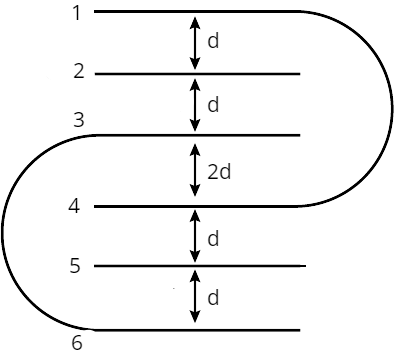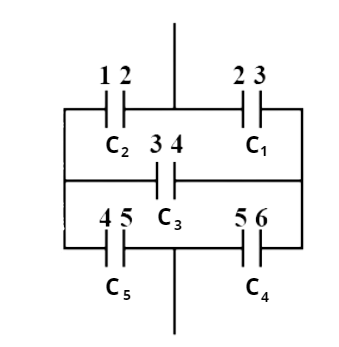
There are six plates of equal are $A$ and separation between the plates is $\mathrm{d}(\mathrm{d} \ll \mathrm{A})$ are arranged as shown in figure. The equivalent capacitance between points 2 and 5 , is $\alpha \dfrac{\varepsilon_{0} \mathrm{~A}}{\mathrm{~d}}$. Then find the value of $\alpha$.

Answer
217.8k+ views
Hint: An electrical device with two terminals known as a capacitor has the capacity to store energy in the form of an electric charge. It is made up of two electrical wires that are spaced apart by a certain amount. Vacuum may be used to fill the space between the conductors, or a dielectric, an insulating substance, may be used instead. Capacitance is the term used to describe a capacitor's capacity to hold charges.
Formula used:
The expression of capacitance is,
$C=\dfrac{{{\varepsilon }_{0}}A}{d}$
Here, A is the area of the cross section of the plate and d is the distance between the plates.
Complete step by step solution:
Rearrange the given plates as shown below

From this we get
${{C}_{1}}=\dfrac{{{\varepsilon }_{0}}A}{d},$
$\Rightarrow {{C}_{2}}=\dfrac{{{\varepsilon }_{0}}A}{2d}$
$\Rightarrow {{C}_{3}}=\dfrac{{{\varepsilon }_{0}}A}{3d},$
$\Rightarrow {{C}_{4}}=\dfrac{{{\varepsilon }_{0}}A}{2d},$
$\Rightarrow {{C}_{5}}=\dfrac{{{\varepsilon }_{0}}A}{d}$
$C_{1}$ and $C_{2}$ are in series and its effective capacity is
$\dfrac{\dfrac{\varepsilon_{0} A}{d} \times \dfrac{\varepsilon_{0} A}{2 d}}{\dfrac{\varepsilon_{0} A}{d}+\dfrac{\varepsilon_{0} A}{2 d}}=\dfrac{\varepsilon_{0} A}{3 d}$
The ratio of a system's electric charge change to the equivalent change in its electric potential is known as capacitance.
The effective capacitance of $C_{4}$ and $C_{3}=\dfrac{\varepsilon_{0} A}{3 d}$ is,
${{C}_{AB}}=\dfrac{{{\varepsilon }_{0}}A}{3d}+\dfrac{{{\varepsilon }_{0}}A}{3d}+\dfrac{{{\varepsilon }_{0}}A}{3d}$
$\Rightarrow C_{A B}=\dfrac{\varepsilon_{0} A}{3 d}+\dfrac{\varepsilon_{0} A}{3d}+\dfrac{\varepsilon_{0} A}{3 d}$
$\Rightarrow C_{A B}=\dfrac{\varepsilon_{0} A}{d}$
Substituting values we get
So the value of $\alpha =1$
Hence, the value of $\alpha$ is 1.
Note: The reciprocal of the equivalent capacitance when numerous capacitors are linked in series is equal to the total of the reciprocals of the individual capacitances. The equivalent capacitance is the total of the individual capacitances when many capacitors are connected in a parallel configuration. When numerous capacitors are linked in parallel, the equivalent capacitance is the sum of the individual capacitances. When a network of capacitors comprises a combination of series and parallel connections, we identify the series and parallel networks and compute their equal capacitances stepwise until the entire infrastructure is limited to a single equivalent capacitance.
Formula used:
The expression of capacitance is,
$C=\dfrac{{{\varepsilon }_{0}}A}{d}$
Here, A is the area of the cross section of the plate and d is the distance between the plates.
Complete step by step solution:
Rearrange the given plates as shown below

From this we get
${{C}_{1}}=\dfrac{{{\varepsilon }_{0}}A}{d},$
$\Rightarrow {{C}_{2}}=\dfrac{{{\varepsilon }_{0}}A}{2d}$
$\Rightarrow {{C}_{3}}=\dfrac{{{\varepsilon }_{0}}A}{3d},$
$\Rightarrow {{C}_{4}}=\dfrac{{{\varepsilon }_{0}}A}{2d},$
$\Rightarrow {{C}_{5}}=\dfrac{{{\varepsilon }_{0}}A}{d}$
$C_{1}$ and $C_{2}$ are in series and its effective capacity is
$\dfrac{\dfrac{\varepsilon_{0} A}{d} \times \dfrac{\varepsilon_{0} A}{2 d}}{\dfrac{\varepsilon_{0} A}{d}+\dfrac{\varepsilon_{0} A}{2 d}}=\dfrac{\varepsilon_{0} A}{3 d}$
The ratio of a system's electric charge change to the equivalent change in its electric potential is known as capacitance.
The effective capacitance of $C_{4}$ and $C_{3}=\dfrac{\varepsilon_{0} A}{3 d}$ is,
${{C}_{AB}}=\dfrac{{{\varepsilon }_{0}}A}{3d}+\dfrac{{{\varepsilon }_{0}}A}{3d}+\dfrac{{{\varepsilon }_{0}}A}{3d}$
$\Rightarrow C_{A B}=\dfrac{\varepsilon_{0} A}{3 d}+\dfrac{\varepsilon_{0} A}{3d}+\dfrac{\varepsilon_{0} A}{3 d}$
$\Rightarrow C_{A B}=\dfrac{\varepsilon_{0} A}{d}$
Substituting values we get
So the value of $\alpha =1$
Hence, the value of $\alpha$ is 1.
Note: The reciprocal of the equivalent capacitance when numerous capacitors are linked in series is equal to the total of the reciprocals of the individual capacitances. The equivalent capacitance is the total of the individual capacitances when many capacitors are connected in a parallel configuration. When numerous capacitors are linked in parallel, the equivalent capacitance is the sum of the individual capacitances. When a network of capacitors comprises a combination of series and parallel connections, we identify the series and parallel networks and compute their equal capacitances stepwise until the entire infrastructure is limited to a single equivalent capacitance.
Recently Updated Pages
Young’s Double Slit Experiment Derivation Explained

Wheatstone Bridge Explained: Working, Formula & Uses

Chemical Properties of Hydrogen - Important Concepts for JEE Exam Preparation

JEE General Topics in Chemistry Important Concepts and Tips

JEE Atomic Structure and Chemical Bonding important Concepts and Tips

JEE Amino Acids and Peptides Important Concepts and Tips for Exam Preparation

Trending doubts
JEE Main 2026: Application Form Open, Exam Dates, Syllabus, Eligibility & Question Papers

Derivation of Equation of Trajectory Explained for Students

Hybridisation in Chemistry – Concept, Types & Applications

Understanding the Angle of Deviation in a Prism

Understanding Collisions: Types and Examples for Students

Understanding Atomic Structure for Beginners

Other Pages
JEE Advanced Marks vs Ranks 2025: Understanding Category-wise Qualifying Marks and Previous Year Cut-offs

How to Convert a Galvanometer into an Ammeter or Voltmeter

Ideal and Non-Ideal Solutions Explained for Class 12 Chemistry

Degree of Dissociation: Meaning, Formula, Calculation & Uses

Understanding Electromagnetic Waves and Their Importance

Understanding Average and RMS Value in Electrical Circuits




